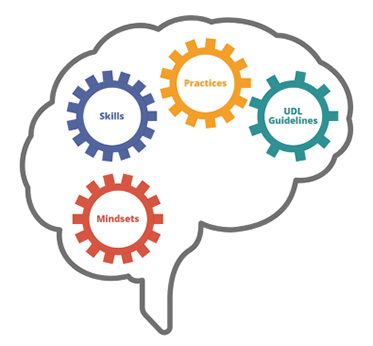What does UDL look like? Introducing The UDL Gears
Asking what Universal Design for Learning (UDL) looks like is like asking what a sunset looks like. Just as each sunset looks different every day, UDL looks different every time it is put into action. Topography and weather determine how the sunset looks. Location, materials, and the complexity of human interactions determine how UDL looks. So, what helps us recognize sunsets and UDL? Both have consistencies across the elements. Sunsets have the sun, provide us with spectacular colors, and signify the end of a day. UDL also has consistencies and those can be described using four interlocking gears like you see in the image on this page (also available as an EPUB).
The four gears represent the mindset and skills of the instructional leader[1], the practices that the instructional leader uses, and the direction taken from the UDL Guidelines. While each gear represents an important part of UDL, successful UDL application relies on all four gears moving together. The cogs are what connect the gears and keep them moving. When a cog in a gear goes missing, the other gears cannot function as smoothly because they cannot connect and use their combined power. When this happens, the application of UDL is not as successful.
The components of each gear come from global literature including research, books, and gray literature on best practices across inclusion and UDL implementation. Hover your mouse over the center of each gear as well as the cogs to learn more.
How does this image connect to The Tapestry?
The tapestry and the gears offer two different angles of UDL. While the Tapestry helps the UDL learner[2] see all of the threads that weave together to create the richness of UDL, the Gears help the learner see the action of UDL.
Please cite as
Nelson, L. L. (2023, May 24). The UDL Gears. https://theudlapproach.com/theudlgears

